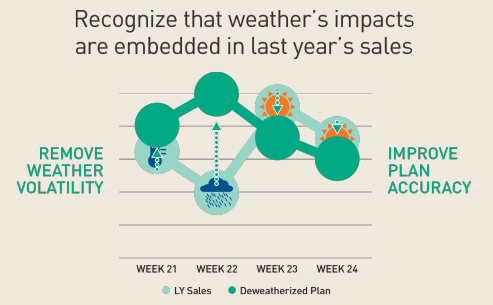Weather & Retail Myth #1: You Can’t Plan for the Weather
What does 53°F and light rain mean for sales? The answer is different in Chicago than in Charlotte; it varies if it is a day in March or October. The weather’s influence on consumers is complex and nuanced and temperature or precipitation data is easily misinterpreted and misused. As a result, many businesses believe planning for weather’s impact on sales is an exercise in futility.
However, ignoring the effect of something with such a profound impact on consumers’ day-to-day lives can lead to severe miscalculations in everything from sales and inventory to markdowns and staffing levels. To help retailers understand how to anticipate and plan around the weather, the National Retail Federation and Planalytics have identified five common weather myths that affect retailers and how to effectively incorporate weather considerations to make better decisions.
MYTH 1: YOU CAN’T PLAN FOR THE WEATHER
Because specific weather events — heat waves, snowstorms, cold snaps, etc. — cannot be precisely forecasted in advance, it can be challenging for businesses to react to near-term opportunities or risks. This is particularly true for retail, where decisions around demand planning, supply chain operations, labor scheduling, marketing and more are determined weeks, if not months, in advance. However, viewing the weather as “a force that can’t be reckoned with” can lead to significant miscalculations in sales or inventory forecasting. Instead, retailers should proactively account for weather’s impact in three areas of business:
PLANNING: The weather — and its impact on business — only repeats from one year to the next about 15 percent of the time, though it’s common for plans to be heavily based on or influenced by the prior year. This leads many companies to unwittingly embed the previous year’s weather variations and sales impacts into their business forecasts. Retailers can remove much of this built-in error by deweatherizing their sales history. This process uses weather-driven demand calculations to systematically remove weather-based sales distortions and provide a cleansed, normalized baseline for planning. Weather-driven demand is the quantification of the impact of weather — and weather alone — on demand for a product or service.

Through deweatherization, retailers improve total enterprise forecast accuracy by several percentage points on average, and up to 50 percent for specific product categories.
LOCALIZED STRATEGIES: There is a danger of creating false answers through an oversimplified approach. Without analyzing weather and sales information at both the market and the weekly level, it is easy to get the weather drivers and volume impacts wrong. For example, an assumption that every one-degree temperature increase delivers a 7,500-unit sales increase will be inaccurate when looking at different locations, distinct times of the year and various merchandise categories.
STAFFING: Retailers are not only managing the cost of carrying inventory; they are also charged with staffing stores appropriately to manage the influx of shoppers. Weather has a direct influence on store traffic. By utilizing weather-driven demand calculations, businesses can prepare for and quickly adjust store staffing to better accommodate varying traffic levels, maximizing the efficiency of individual stores and better managing to budgets.
Check out the 5 Myths About the Weather & Its Impact on Retail from the NRF to learn more.
